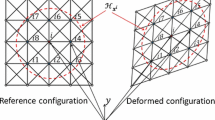Abstract
A tensegrity structure’s self-vibrational behavior is investigated to validate explanations that the natural frequencies of the tensegrity are composed of the individual natural frequency of strut and cable elements. Tensegrity structure is described as a “self-stressing” object to maintain its equilibrium state. In the equilibrium state, struts are designated to be in compressive state, and cables are designated to be in tensile state. Because all the tensegrity structure elements are connected to preserve the equilibrium state, no boundary condition is needed. To solve this kind of structure by using the conventional finite element procedure is not feasible. Little study has been done to explore the self-vibrational behavior of a tensegrity structure. Previous studies of vibrational tensegrity behavior are limited to specific kind of modular tensegrity (cylinder, sphere) and predefined simple geometric form of tensegrity with some boundary supported nodes to avoid rigid body motion. In this paper, the self-vibrational dynamic equations of the prestressed strut, which is treated as an axially vibrating element, and the prestressed cable, which is treated as a transversally vibrating element, are derived consistently in the frequency domain in the context of spectral element procedure. The Wittrick-Williams procedure uses the determinant value of the equilibrium equation matrix; thus, no singularity problem is encountered. The derived self-vibrational dynamic equations are applicable for general tensegrity form without predefined conditions necessary. A numerical example is presented to demonstrate the efficiency of the present study.
Access this chapter
Tax calculation will be finalised at checkout
Purchases are for personal use only
Similar content being viewed by others
References
Banerjee, J.R.: Dynamic stiffness formulation for structural elements: a general approach. Comput. Struct. 63(1), 101–103 (1977)
Leung, A.Y.T.: Dynamic Stiffness and Substructures. Springer-Verlag, London (1993)
Doyle, J.F.: Wave Propagation in Structures: Spectral Analysis Using Fast Discrete Fourier Transforms. Springer, New York (1997)
Narayanan, G.V., Beskos, D.E.: Use of dynamic influence coefficients in forced vibration problems with the aid of fast Fourier transform. Comput. Struct. 9(2), 145–150 (1978)
Lee, U.: Spectral Element Method in Structural Dynamics. John Wiley & Sons (Asia) Pte Ltd, Singapore (2009)
Gan, B.S., Zhang, J., Nguyen, D.K., Nouchi, E.: Node-based genetic form-finding of irregular tensegrity structures. Comput. Struct. 159, 61–73 (2015)
Gan, B.S.: Computational Modeling of Tensegrity Structures. Springer-Nature, Switzerland (2020)
Motro, R., Najari, S., Jouanna, P.: Tensegrity systems. From design to realization. In: Proceedings of the First International Conference on Lightweight Structures in Architecture (1986)
Furuya, H.: Concept of deployable tensegrity structures in space applications. J. Space Struct. 7(2), 143–151 (1992)
Moussa, B., Ben Kahla, N., Pons, J.C.: Evolution of natural frequencies in tensegrity systems: a case study. J. Space Struct. 16(1), 57–73 (2001)
Murakami, H.: Static and dynamic analyses of tensegrity structures. Part 1. Nonlinear equations of motion. Int. J. Solids Struct. 38(20), 3599–3613 (2001)
Oppenheim, I.J., Williams, W.O.: Vibration of an elastic tensegrity structure. Eur. J. Mech. Solids 20(6), 1023–1031 (2001)
Sultan, C., Corless, M., Skelton, R.E.: Linear dynamics of tensegrity structures. J. Eng. Struct. 24, 671–685 (2002)
Wittrick, W.H., Williams, F.W.: A general algorithm for computing natural frequencies of elastic structures. Q. J. Mech. Appl. Math. 24(3), 263–284 (1971)
Stamenovic, D., Ingber, D.E.: Models of cytoskeletal mechanics of adherent cells. Biomech. Model. Mechanobiol. 1, 95–108 (2002)
Author information
Authors and Affiliations
Corresponding author
Editor information
Editors and Affiliations
Rights and permissions
Copyright information
© 2022 The Author(s), under exclusive license to Springer Nature Singapore Pte Ltd.
About this paper
Cite this paper
Gan, B.S. (2022). Self-vibrational Analysis of a Tensegrity. In: Tien Khiem, N., Van Lien, T., Xuan Hung, N. (eds) Modern Mechanics and Applications. Lecture Notes in Mechanical Engineering. Springer, Singapore. https://doi.org/10.1007/978-981-16-3239-6_7
Download citation
DOI: https://doi.org/10.1007/978-981-16-3239-6_7
Published:
Publisher Name: Springer, Singapore
Print ISBN: 978-981-16-3238-9
Online ISBN: 978-981-16-3239-6
eBook Packages: EngineeringEngineering (R0)




